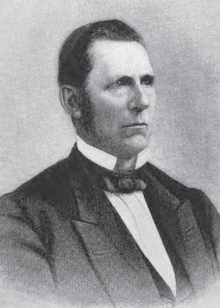Rufus P. Ranney
Rufus Putnam Ranney (October 30, 1813 – December 6, 1891) was a Democratic politician in the U.S. State of Ohio who helped write the second Ohio Constitution, and was a judge on the Ohio Supreme Court in 1851–1856 and 1863–1865.
Rufus Putnam Ranney | |
|---|---|
 | |
| Justice of the Ohio Supreme Court | |
| In office March 17, 1851 – February 15, 1857 | |
| Preceded by | Edward Avery |
| Succeeded by | Josiah Scott |
| In office February 9, 1863 – February 23, 1865 | |
| Preceded by | Milton Sutliff |
| Succeeded by | John Welch |
| Personal details | |
| Born | October 30, 1813 Blandford, Massachusetts |
| Died | December 6, 1891 (aged 78) Cleveland, Ohio |
| Resting place | Lake View Cemetery |
| Political party | Democratic |
| Spouse(s) | Adeline W. Warner |
| Children | six |
| Alma mater | Western Reserve College |
| Signature | |
Rufus Putnam Ranney was born at Blandford, Hampden County, Massachusetts. The family moved to Portage County, Ohio in 1824. He earned enough money chopping firewood to enter Western Reserve College then at Hudson, but not enough to complete the college course. At age 21[1] or 22[2] he began the study of law at the office of Joshua Reed Giddings and Benjamin Wade, and was admitted to the bar in 1836.
Legal
The firm of Wade and Ranney was formed because Giddings was elected to Congress. In 1845, Wade became judge of the Common Pleas before entering the Senate in 1851. In 1846, Ranney moved to Warren, Trumbull County. The Democrats nominated him for Congress in 1846 and 1848, in a district "hopelessly in the minority".[2]
Political
In 1850, in heavily Whig Trumbull and Geauga counties, Ranney was elected to the second State Constitutional Convention. He served on the committees on the judiciary, on revision, and on amendments. Also on the judiciary committee were Henry Stanbery, Joseph Rockwell Swan, William S. Groesbeck, and William Kennon, Sr..[2]
In 1892, a committee of the Ohio Bar, including Allen G. Thurman, Jacob Dolson Cox, F.E. Hutchins, and Samuel E. Williamson had this to say of Ranney's work at the convention:
Although he was then a young man he was soon recognized as one of the leading members of the convention. In this body of distinguished lawyers, jurists and statesmen, there were few members who had as thorough knowledge of political science, constitutional law, political and judicial history and the principles of jurisprudence as Judge Ranney displayed in the debates of the convention. There was no more profound, acute and convincing reasoner on the floor of the convention, and in the committee rooms his suggestions and enlightened mind were invaluable. The amended constitution conforms very nearly to the principles and provisions advocated by him.
— Ohio Bar Committee, 1892[2]
Judicial
In March, 1851, under the old constitution, the General Assembly elected Ranney to the Supreme Court to succeed Judge Avery. Later that year, he was elected by the public, under the new Constitution, to a five-year term on the Supreme Court. In 1856, Josiah Scott defeated Ranney and a third party candidate for the seat. Ranney resigned shortly after the election, and Scott was seated late in 1856. Ranney began law practice at Cleveland in the firm Ranney, Backus, and Noble.[2] In 1857 he was United States Attorney for the Northern District of Ohio.[3]
In 1859, Ranney was nominated the Democratic candidate for Governor, but lost to Republican William Dennison. In 1862, the Democrats nominated Ranney for Supreme Court again, and the Republicans nominated his law partner Franklin T. Backus. Ranney won, was seated February 1863, and resigned February 23, 1865 to return to private practice in Cleveland.[2]
In 1874, he was appointed an Ohio Commissioner of the Centennial Exposition in Philadelphia[4]
The Ohio State Bar Association was organized in 1881. Ranney was selected the first president of the association. Ranney died at home in Cleveland December 6, 1891.[2] He was buried at Lake View Cemetery.[5]
Ranney was married to Adeline W. Warner, and had four sons and two daughters.[1]
Notes
- Neff 1921 : 218–221
- Randall 1912 Volume 5 : 147–150
- "U.S. Attorney, Northern District of Ohio". United States Court of Appeals for the Sixth Circuit. Archived from the original on 2009-05-13. Retrieved 2012-01-19.
- Gilkey 1901 : 770
- The Supreme Court of Ohio and The Ohio Judicial System - Rufus P. Ranney
References
- Randall, Emilius; Ryan, Daniel Joseph (1912). History of Ohio: the Rise and Progress of an American State. 5. New York: The Century History Company.
- Neff, William B, ed. (1921). Bench and Bar of Northern Ohio History and Biography. Cleveland: The Historical Publishing Company. p. 218.
Ranney.
- Gilkey, Elliott Howard, ed. (1901). The Ohio Hundred Year Book: a Handbook of the Public Men and Public Institutions of Ohio ... State of Ohio.
Further reading
- Gold, David M. (2017). The Jacksonian Conservatism of Rufus P. Ranney: The Politics and Jurisprudence of a Northern Democrat from the Age of Jackson to the Gilded Age. Ohio University Press. ISBN 978-0821422342.
External links
- Rufus P. Ranney at Find a Grave

. Appletons' Cyclopædia of American Biography. 1900.
| Legal offices | ||
|---|---|---|
| Preceded by Edward Avery |
Ohio Supreme Court Judges 1851-1857 |
Succeeded by Josiah Scott |
| Preceded by Milton Sutliff |
Ohio Supreme Court Judges 1863-1865 |
Succeeded by John Welch |
| Preceded by new office |
President of the Ohio State Bar Association July, 1880 - July, 1881 |
Succeeded by Rufus King |
| Party political offices | ||
| Preceded by Henry B. Payne |
Democratic Party nominee for Governor of Ohio 1859 |
Succeeded by Hugh J. Jewett |